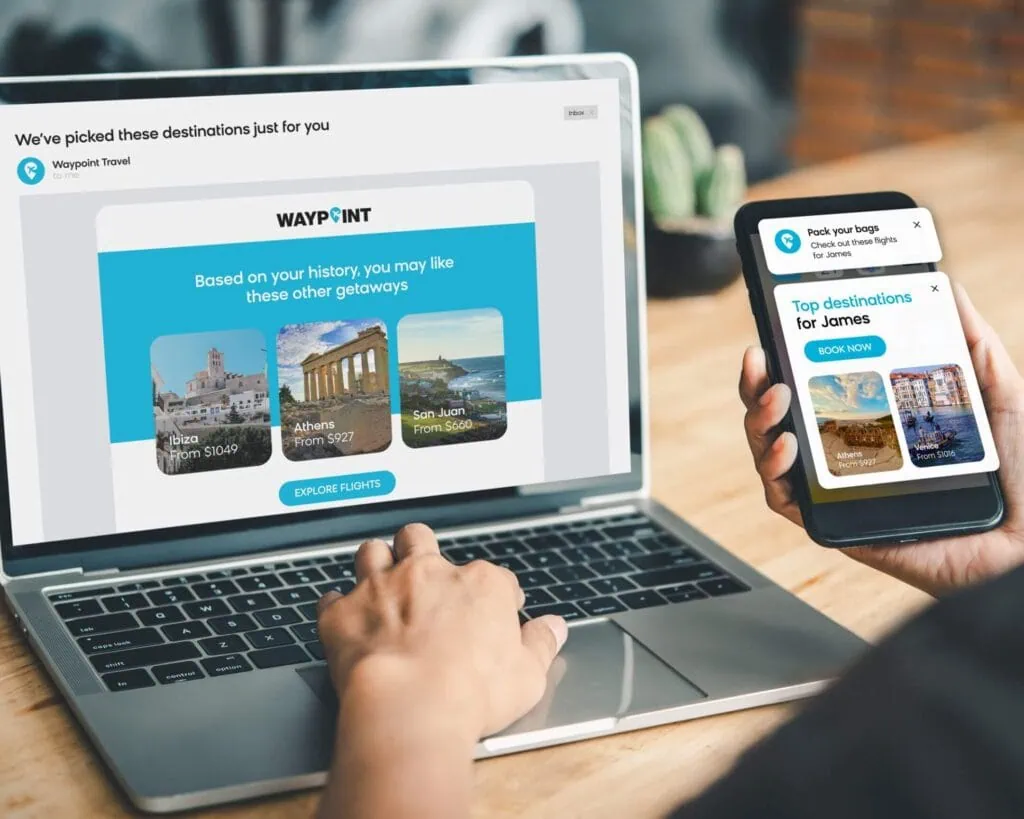Think about the last time you went grocery shopping. How many different places did you visit to find everything you needed?
Did you buy everything at one store, or, like most people, visit a mix of places: a grocery store, farmers’ market, maybe even the drugstore for quick essentials?
Just like how you source groceries from different places, today’s shoppers make purchases across multiple platforms. Gone are the days when people only visited a website to make a purchase. Now, shopping happens through social media, emails, texts, and more.
Cross-channel marketing automation makes this shift manageable. It lets you run smooth, consistent campaigns across all those channels without having to juggle them separately.
In a world where people jump between different touchpoints, an integrated approach helps keep your marketing messages clear and keeps customers coming back, improving engagement and ROI. Keep reading to learn how cross-channel automation can supercharge your business growth.
What Is Cross-Channel Marketing Automation?
Cross-channel marketing automation unites channels like email, SMS, social media, and web to create a seamless, cohesive customer journey.
It’s different from multichannel and omnichannel approaches. Multichannel marketing means running separate strategies for each platform. Omnichannel involves more complex, AI-driven insights, which can be a lot to take on for companies new to automation. Cross-channel marketing sits comfortably in the middle, allowing brands to coordinate their messaging across platforms without diving too deep into heavy data or predictions.
Cross-channel marketing is especially useful for brands that want to keep customers engaged throughout the buying journey. For example, a skincare brand could start with an email promoting a new eye serum, follow up with an SMS reminder for anyone who didn’t open it, and later show targeted social media ads to stay connected.
The goal is to guide current and potential customers seamlessly across platforms, without overwhelming or interrupting their experience. This keeps them interested and less likely to drop off.
Examples of Cross-Channel Marketing Automation
Every marketing channel has its strengths. Text messages grab attention fast, while email is a reliable sales driver. Cross-channel marketing efforts take a coordinated approach, using each channel’s strengths to keep your brand top of mind for consumers. Here are a few common examples:
- Abandoned cart recovery: Your customer leaves items in their cart without completing the purchase. To drive them back to their cart, your brand sends an email with a reminder, then follows up with a targeted social media ad showcasing the items they left behind. Later, if your customer still hasn’t completed the purchase, an SMS message offers an extra discount to incentivize them to buy.
- Birthday campaigns: Birthday campaigns are a hit with shoppers, generating 342% more revenue than regular campaigns. Start with a mobile app notification offering a gift or discount as your customer’s birthday approaches. Then, send a personalized email or SMS with a unique birthday code and follow up with another message on their actual birthday.
- Product launches: To promote a new product, your brand begins by posting a teaser video on social media as well as a weblayer on the site to build anticipation. Then, you send an email with the product details and a limited-time offer. After the product has launched, you can follow up with SMS, offering additional recommendations based on what your customer wants to see.
What Tools Do You Need for Cross-Channel Marketing Automation?
Implementing an effective cross-channel marketing strategy requires an integrated suite of marketing automation tools that work together seamlessly. Common tools include:
- CRM software: CRM software tracks customer interactions and manages relationships across channels. This functions as the home base of your cross-channel marketing campaigns since it houses your customer profiles along with all the relevant information to the tools on this list.
- Email marketing platforms: You’ll need an email marketing platform to send automated campaigns triggered by specific customer behaviors. Though it’s not a new technology, email marketing still reigns supreme, with recent data showing it’s more popular than ever. Clickthrough rates rose from 2.7% in 2022 to 4.3% in 2023, reflecting increased engagement with email content.
- Social media management tools: Nearly 95% of global internet users are active on social media, making it a powerful opportunity for savvy brands. Using a management tool is essential for effectively reaching new customers, as it lets you schedule, publish, and monitor posts across different platforms. In fact, social media management is the second-most used platform for marketing automation, with half of marketers reporting they used automation for social media in 2023.
- Analytics tools: Not to be confused with your CRM software, which houses data about your existing customers, analytics tools will gather data and insights on campaign performance, customer engagement, and conversion metrics to make it easier to find new customers.
An all-in-one platform like Bloomreach can streamline this process by providing all the tools needed to create a seamless, data-driven user experience.
Omnichannel vs. Cross-Channel vs. Multichannel Marketing: What’s the Difference?
Marketers often use terms like multichannel, cross-channel, and omnichannel interchangeably, but each approach has distinct characteristics:
| Marketing Approach | Description | Example |
| Multichannel Marketing | Uses multiple channels to reach customers, but each channel operates independently. | Separate campaigns for email, social media, and SMS with no integration. |
| Cross-Channel Marketing | Coordinates multiple channels to create a cohesive customer journey. Focuses on guiding customers through multiple touchpoints. Offers less integration and cohesion than omnichannel. | A campaign that combines email and social media reinforces the message across both campaigns. |
| Omnichannel Marketing | Fully integrates all channels and data to deliver a unified, personalized experience. Each interaction informs the next, creating seamless, personalized customer experiences. | When a customer clicks on a specific product in an email, the system notes this customer interaction and updates the personalization across every other channel. This results in a seamless, personalized journey. |
How Bloomreach Can Support Your Marketing Automation Journey
For marketing teams looking to improve their cross-channel strategy, Bloomreach offers the tools to create personalized, data-driven experiences across different channels. Our platform uses real-time data and powerful AI to ensure you’re delivering consistent, meaningful interactions with your target audience, no matter where they are.
Here are a few ways Bloomreach can help you make the most of cross-channel marketing automation:
Integration and Consistency Across All Channels
Bloomreach merges customer data from multiple touchpoints, giving you a complete view of each customer’s journey. This integration allows marketers to send personalized messages across email, SMS, social media, and websites, helping to build deeper, more meaningful relationships. By meeting customers where they are and delivering a smooth, consistent experience across channels, brands can create a memorable journey that drives customer loyalty and increases customer lifetime value.
Real-Time Personalization To Engage Customers
One of Bloomreach’s standout features is its real-time personalization. Using AI-driven insights, Bloomreach tailors content and recommendations to each customer’s behavior, preferences, and interactions, delivering a dynamic experience that keeps customers engaged and boosts conversion rates. Bloomreach shows the right products, offers, or content at the right time so that every brand interaction feels relevant. This increases the chances of a purchase since customers are more likely to act on recommendations that match their needs and interests.
Advanced Analytics for Better Insights
Bloomreach also provides powerful analytics tools to track your campaign performance. These insights help you understand what drives customer value, engagement, and churn, so you can adjust your strategy and segment customers effectively. With this data, you can optimize AI-powered campaigns in real time, focusing on the most effective channels and personalizing messaging to keep customers engaged. Over time, this boosts engagement, improves retention, and increases revenue.
Try Bloomreach for Seamless Customer Journeys With Automated Workflows
In an ideal world, your customer would shop on just one channel, and you’d only need to focus on optimizing that platform. However, the reality is that today’s ecommerce landscape is filled with multiple platforms and ever-changing customer preferences. As ecommerce marketers, it’s our job to meet shoppers wherever they are.
Bloomreach makes it easy for brands to build automated workflows that create seamless, engaging experiences from awareness to conversion. Our platform streamlines cross-channel marketing, helping businesses connect with customers at every touchpoint and deliver consistent, personalized journeys that drive results.
Your customer experience is everything, and Bloomreach can take it to the next level with powerful marketing automation. That’s why Bloomreach was named a Strong Performer in the Forrester Wave™: Cross-Channel Marketing Hubs for Q4 2024. Learn more about our achievement here.













